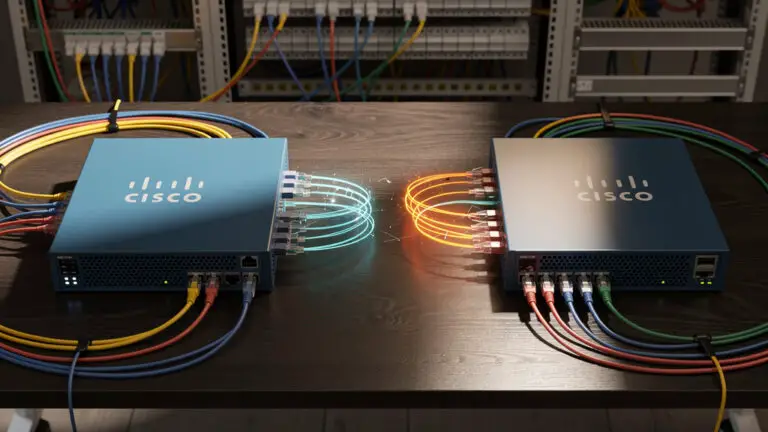USB ports on home routers have evolved from simple accessory slots to powerful connectors that significantly expand your network’s capabilities beyond basic internet connectivity. These versatile ports now facilitate robust file and media sharing, seamless printer sharing, and even provide critical cellular modem connectivity for internet failover. In this updated guide, I’ll take you through the diverse and increasingly sophisticated uses of USB ports on modern routers, showing you how they can streamline and enhance your home or small office network setup.
I’ll delve into each of these functionalities to give you a clear understanding of how to maximize your router’s potential, ensuring you’re leveraging the latest standards and best practices for your home or small office network.
Key Takeaways
- Modern routers are increasingly equipped with USB 3.2 Gen 1 (formerly USB 3.0), and sometimes even USB 3.2 Gen 2, ports that significantly expand their functionality beyond basic networking tasks.
- Router USB ports are excellent for file and media sharing, printer sharing, cellular modem connectivity for failover, and basic device charging.
- USB 3.x ports offer substantially faster speeds than USB 2.0 but can still cause interference with 2.4 GHz Wi-Fi signals if not properly shielded. Modern routers often mitigate this with advanced designs.
- Setting up and managing USB features is typically straightforward via the router’s web-based interface, with some routers offering advanced APIs for management.
- While USB routers provide a cost-effective entry point for sharing, dedicated NAS and print servers offer superior performance, scalability, and security for more demanding home or small office networks.
Below are some of my favorite routers with USB ports, considering their features and current market value:








Types of USB Ports on Routers
Routers today typically feature a mix of USB 2.0, USB 3.2 Gen 1 (which was previously known as USB 3.0 and USB 3.1 Gen 1), and increasingly, USB 3.2 Gen 2 ports. While USB 2.0 provides a theoretical maximum speed of 480 Mbps, USB 3.2 Gen 1 significantly boosts this to 5 Gbps. For high-demand applications, some premium routers now offer USB 3.2 Gen 2, capable of up to 10 Gbps, or even USB-C ports with USB4 readiness for future-proofing.
The number of USB ports on a router is model-dependent. You might find a single USB port on basic models, while more advanced routers, like the ASUS AX88U or certain NETGEAR Nighthawk series, commonly feature dual or multiple ports, often combining USB 3.2 Gen 1 with USB 2.0 or even multiple USB 3.2 Gen 2 ports for enhanced versatility. The faster speeds of USB 3.x are particularly advantageous for data-intensive tasks such as large file transfers or high-definition media streaming, making your router a more capable network hub.
See also:
- How to Configure Guest Networks on Home WiFi Routers
- MAC Address Filtering on Home Routers
- Dynamic DNS or DDNS on Home Routers
- Port Forwarding on Home Routers
- Mastering QoS Settings on Home Router
USB Functionality on Routers
File and Media Sharing
One of the most compelling reasons to use a router’s USB feature is for file and media sharing. By connecting an external hard drive, SSD, or flash drive to your router’s USB port, you can transform it into a rudimentary Network Attached Storage (NAS) solution. This setup allows any device on your network to access shared files, photos, videos, and documents, creating a convenient central repository.
Leveraging a router USB hard drive or USB flash drive for file sharing offers distinct advantages, especially for home users:
- Centralized Access: All your digital assets are stored in one location, easily accessible from any networked device without manual transfers.
- Ease of Use: You avoid the hassle of transferring files between individual devices or relying solely on cloud storage, which might incur subscription fees or bandwidth limits.
- Cost-Effectiveness: For basic needs, utilizing your existing router’s USB port with an external drive is significantly more affordable than investing in a dedicated NAS device.
Many modern routers, including high-end Wi-Fi 6 and Wi-Fi 7 models like the TP-Link Archer series and Linksys models, come with robust media server capabilities. These allow you to stream media files directly from your connected USB storage to compatible devices such as smart TVs, gaming consoles, and media players that support standards like DLNA (Digital Living Network Alliance) or SMB (Server Message Block).
Printer Sharing
Another highly practical use for wireless router USB ports is network-wide printer sharing. By connecting a traditional USB printer to your router, you can make it accessible to all wired and wireless devices on your network. This eliminates the need for a separate print server or the added expense of purchasing a Wi-Fi-enabled printer, especially useful if you have an older, reliable USB-only printer.
To configure USB printer sharing, you typically connect your printer to the router’s USB port and then enable the print server function within the router’s web interface. You’ll still need to install the appropriate printer drivers on your client devices (Windows, macOS, Linux) and then add the shared printer by referencing the router’s IP address or hostname. Most contemporary routers, even mid-range models, offer straightforward interfaces for managing the connected printer.
Cellular Modem Connectivity
Routers equipped for 3G/4G/5G USB modem connectivity, often marketed as cellular modem routers, allow you to connect a USB cellular modem for an internet failover solution. This feature is invaluable for ensuring continuous internet access if your primary broadband connection fails, or for establishing internet in locations where traditional broadband isn’t available.
To leverage this, you’ll need a compatible 3G, 4G, or increasingly, 5G USB modem from your cellular service provider. Once connected to the router’s USB port, you can configure the router’s WAN settings to automatically switch to the cellular connection upon detecting an outage of the primary internet source. It’s crucial to check your router’s compatibility list for specific modem models and ensure its firmware is up-to-date to support the latest cellular technologies and carriers.
Charging Devices
While not a primary function for network optimization, the USB ports on many routers can also be used for basic charging of smartphones, tablets, and other USB-powered devices. This can be a handy convenience, especially if your router is centrally located. However, be aware that most router USB ports provide limited power output (typically 0.5A to 1.5A), which is generally insufficient for fast charging modern devices or powering high-draw accessories reliably.
Potential Drawbacks and Solutions
USB 3.0 Interference with 2.4 GHz Wi-Fi
One known challenge with USB 3.x routers is the potential for interference between USB 3.0 (now USB 3.2 Gen 1) ports and 2.4 GHz Wi-Fi signals. This occurs because USB 3.x operations generate electromagnetic interference (EMI) that can spill into the 2.4 GHz frequency band, potentially leading to reduced Wi-Fi performance, slower speeds, and diminished range on that band.
Router manufacturers have actively addressed this issue through various mitigation strategies:
- Enhanced Shielding: Implementing better internal and external shielding for USB 3.x ports and cables to contain EMI.
- Strategic Port Placement: Designing router layouts that place USB ports away from internal Wi-Fi antennas to minimize signal coupling.
- Frequency Prioritization: Encouraging users to utilize the 5 GHz or 6 GHz Wi-Fi bands for devices that require high bandwidth, as these bands are unaffected by USB 3.x interference.
When deploying a USB 3.x router, it’s wise to consider the physical placement of the router and any connected USB devices, and use shielded USB 3.x cables where possible to further reduce potential interference.
Performance and Security Considerations
While convenient, using a router’s USB port for storage or printer sharing can introduce performance bottlenecks and security concerns. Low-end routers with less powerful processors and limited RAM may struggle to handle both their primary routing/Wi-Fi duties and simultaneous USB device management, leading to slower network speeds, increased latency, and compromised file transfer rates.
To optimize performance and enhance security when using router USB features, I recommend the following:
- Router Hardware: Choose a router with a robust multi-core processor and ample RAM, such as a high-performance Wi-Fi 6E or Wi-Fi 7 model (e.g., Synology RT6600ax, ASUS ROG series), designed to handle multiple tasks concurrently.
- USB Standard: Always use USB 3.2 Gen 1 or Gen 2 ports for connected storage devices to benefit from faster data transfer speeds.
- Traffic Management: Limit concurrent access to USB storage or printers to reduce the load on the router’s CPU.
- Firmware Updates: Regularly update your router’s firmware. This not only ensures optimal performance and compatibility but also patches critical security vulnerabilities.
- Security Protocols: For file sharing, configure your router to use modern SMB protocols (SMBv2 or SMBv3) and disable older, less secure versions like SMBv1. Always use strong, unique passwords for shared folders and user accounts. Avoid exposing USB storage directly to the internet (WAN access) unless absolutely necessary and secured with a VPN or strong authentication.
- Access Control: Implement user accounts and granular permissions to control who can access specific files or the printer.
Setting Up and Using USB Features on Routers
The process for setting up USB features on routers is generally user-friendly, primarily managed through the router’s web interface. Here’s a general guide:
Step-by-Step Guide
- Connect Your USB Device: Physically plug your external hard drive, SSD, flash drive, or printer into an available USB port on your router. Ensure the device is powered on if it requires external power.
- Access Router Interface: Open a web browser on a device connected to your network and enter your router’s IP address (e.g.,
192.168.1.1or192.168.0.1) or its hostname (e.g.,router.asus.com). Log in with your administrative credentials. - Navigate to USB Settings: Look for a section related to USB, storage, or applications. Common labels include “USB Applications,” “USB Services,” “Storage & Backup,” or “Print Server.”
- Configure Device Settings: Within this section, you’ll enable specific functionalities. For file sharing, activate the SAMBA (SMB) or FTP server, create shared folders, set up user accounts, and assign appropriate permissions. For printers, enable the “Print Server” function.
- Save and Restart: Apply your settings. The router may prompt you to reboot for the changes to take full effect.
Accessing and Managing USB Devices
Once configured, accessing your shared USB devices is straightforward:
- Accessing USB Storage: On Windows, open File Explorer and navigate to “Network” or “This PC” and look for your router’s hostname or IP address. On macOS, open Finder, click “Network” or “Go” > “Connect to Server” and enter
smb://[router_IP_address]. Ensure your operating system supports SMBv2/v3 for better security and performance. - Managing USB Printers: Go to your device’s printer settings (e.g., “Printers & Scanners” on Windows/macOS) and add a new printer. You’ll typically choose to add a network or shared printer and then specify the router’s IP address or hostname.
Configuring Failover Internet
For routers that support internet failover with a USB cellular modem:
- Connect Modem: Plug your compatible 3G/4G/5G USB modem into the router’s USB port.
- Access WAN Settings: Navigate to the router’s web-based interface and locate the “WAN,” “Internet,” or “Dual WAN” settings.
- Configure Cellular Connection: Enter the necessary cellular modem settings, such as the APN (Access Point Name), username, and password provided by your cellular carrier.
- Set Failover Rules: Define the conditions under which the router should switch to the cellular connection. This often includes detecting a loss of connection on the primary WAN port, or specific criteria like ping failures to a public IP address. Many advanced routers allow you to set bandwidth thresholds or scheduled failover.
USB Routers vs. Dedicated NAS and Print Servers
While USB routers offer a convenient and budget-friendly entry point for adding network storage and printer sharing, it’s important to understand their limitations compared to dedicated Network Attached Storage (NAS) devices and standalone print servers. For many home users and small offices with basic needs, a USB router is perfectly adequate. However, for more demanding environments, dedicated solutions shine.
Here’s a comparison of the advantages offered by dedicated NAS devices and print servers:
- Superior Performance: Dedicated NAS devices are purpose-built with more powerful CPUs, greater RAM, and optimized operating systems (like Synology’s DSM or QNAP’s QTS). This translates to significantly higher read/write speeds, better concurrent access for multiple users, and smoother media transcoding. Router-based storage rarely matches this throughput.
- Enhanced Scalability and Storage Options: NAS devices typically offer multiple drive bays, supporting RAID configurations for data redundancy (e.g., RAID 1, RAID 5) and allowing for easy storage expansion. Many also support hotter-swappable drives. USB routers are usually limited to a single external drive, without advanced data protection.
- Advanced Features and Data Management: Dedicated NAS solutions come packed with features like cloud backup integration, snapshot capabilities, virtual machine support, advanced media servers (Plex, Emby), sophisticated user access controls, and often a robust app ecosystem. They also provide comprehensive data integrity checks and health monitoring for drives.
- Robust Security: NAS operating systems receive regular security updates, often include built-in firewalls, intrusion detection, and support for multi-factor authentication (MFA), offering a more secure environment for sensitive data than typically found on a router’s USB sharing function.
Despite these advantages, dedicated NAS and print server devices do come with some drawbacks:
- Higher Cost: Standalone NAS units, especially those with multiple drive bays and advanced features, are considerably more expensive than simply utilizing your router’s USB port.
- Increased Complexity: Setting up, configuring, and maintaining a dedicated NAS can be more involved, requiring a steeper learning curve than the relatively simple router interfaces.
- Physical Footprint and Power: Dedicated devices require additional physical space, separate power connections, and contribute to overall energy consumption.
Ultimately, the decision between a USB router and dedicated NAS or print server boils down to your specific needs, performance expectations, and budget. For basic file sharing, media streaming, and print services for a typical home, a modern USB router is an excellent, cost-effective choice. For mission-critical data, high-performance media serving, robust backups, and advanced features in a home office or small business, a dedicated NAS is undeniably the superior investment.
Conclusion
Routers with USB ports are more than just internet gateways; they are versatile hubs capable of significantly enhancing your network’s functionality. From setting up a practical NAS for centralized file and media sharing to enabling convenient wireless printer access and providing essential internet failover with cellular modems, USB routers offer a cost-effective and integrated solution to expand your network’s capabilities.
When selecting a USB router, I advise considering the type and speed of the USB ports (aim for USB 3.2 Gen 1 or better), the router’s processing power and RAM, and its compatibility with the latest USB devices and cellular modems. By correctly configuring and securing your router’s USB features, you can unlock the full potential of your home or small office network, enjoying the benefits of streamlined storage, easy printer sharing, and resilient internet access.
While dedicated NAS and print server devices offer advantages in terms of raw performance, scalability, and advanced features, USB routers remain an excellent and practical choice for most home and small office networks. With the right router and thoughtful configuration, a USB router can be a powerful tool for a truly enhanced network experience.
FAQs
Can I connect multiple USB devices to my router simultaneously?
- Yes, if your router features multiple USB ports, you can often connect several devices, such as a hard drive and a printer, at the same time. Check your router’s manual for specific port capabilities and any limitations.
What is the maximum storage capacity I can connect to my router’s USB port?
- The maximum storage capacity depends on your router’s firmware and hardware specifications. Most modern routers support large storage capacities (e.g., 4TB, 8TB, or more) and common file systems like FAT32, NTFS, and exFAT. Always verify compatibility with your router model.
Can I access my router’s USB storage remotely over the internet?
- Many routers offer remote access features, allowing you to access your USB storage over the internet via FTP, SFTP, or a manufacturer-provided cloud/web-based interface. However, I strongly recommend enabling strong authentication, secure protocols (like SFTP over FTP), and considering a VPN connection for enhanced security when accessing storage remotely to protect your data from unauthorized access.
Will using a router’s USB port for storage impact my network speeds?
- Yes, using a router’s USB port for storage can impact overall network performance, especially on routers with less powerful processors and USB 2.0 ports. To minimize this, choose a high-performance router with a powerful CPU, ample RAM, and utilize USB 3.2 Gen 1 (or faster) ports when possible. This helps to offload processing and maintain network speeds.
Can I use my router’s USB port to share a printer with wireless devices?
- Absolutely. Connecting a USB printer to your router’s USB port and enabling the print server function allows both wired and wireless devices on your network to print to it, providing a cost-effective alternative to a dedicated wireless printer.
- How to Configure a Secure Site-to-Site VPN on Cisco Firepower Complete Guide - December 3, 2025
- Jobs for Network Engineers: Roles, Skills & Pay - December 3, 2025
- How to Change WiFi Password on Any Router : The Last Guide You Need - December 1, 2025




